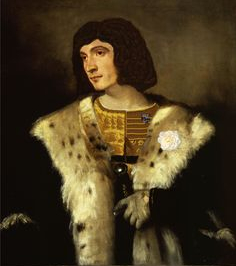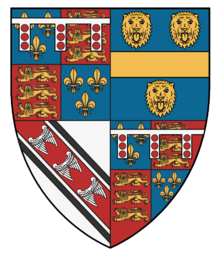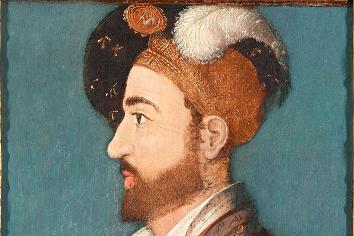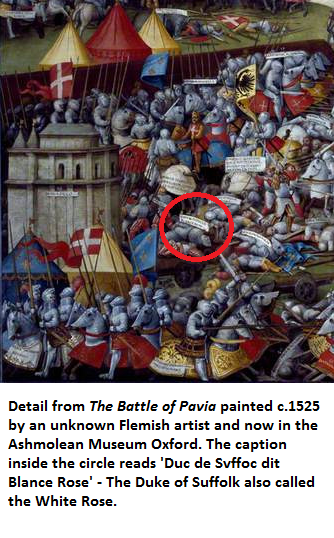THE DE LA POLE BROTHERS
LAST FLOWERING OF THE WHITE ROSE

Victorian painting of John de la Pole 1st Earl of Lincoln
After his only legitimate son died in 1484, Richard III considered his nephews, John de la Pole 1st Earl of Lincoln and his three brothers, as his heirs. The de la Poles certainly had plenty of Yorkist blood in their veins and whilst John was never created Prince of Wales he was granted the revenues of the Duchy of Cornwall -something traditionally given to heir to the throne.
Though John made his peace with the victorious Henry VII, two years after the Yorkists’ defeat at Bosworth he joined the conspiracy to replace the Tudor king with the impostor Lambert Simnel. Using money from his fabulously wealthy aunt, the Yorkist heiress Margaret of Burgundy, John recruited an army of German and Irish mercenaries and set sail for England. He landed in Lancashire but the promised rising in the North never materialised and the rebellion was easily crushed at the Battle of Stoke Field. John de la Pole died in the fighting and the mantle of Yorkist Heir now passed to his brother Edmund.
Edmund adopted the de la Poles’ ancestral title of Duke of Suffolk and left England to seek support for his cause from the Holy Roman Emperor Maximilian but his plans were destroyed by a storm. Maximilian’s son, Philip of Burgundy (the future father of Catherine of Aragon) was shipwrecked in England whereupon Henry VII demanded that the emperor hand over Edmund in exchange for Philip’s release. Edmund was duly sent back to England, on the condition he wouldn’t be harmed, but after spending seven years in The Tower he was executed by the new king Henry VIII.
Edmund was not the only de la Pole to be imprisoned by the Tudors. William, a third brother who seemed to have played little part in any of the de la Pole conspiracies, was sent to the tower in 1502. He never left and after 37 years in captivity he died in 1539. The fourth de la pole brother was more fortunate. Richard, the youngest, managed to escape the Tudor net and flee abroad, first to Aachen and then to Buda in Hungary. On the execution of his brother Edmund, Richard adopted the title Duke of Suffolk and persuaded the French King Louis XII to back a Yorkist invasion.

Arms of Edmund de la Pole 3rd Duke of Suffolk

Early 16th Century protrait of a gentlemen believed to be Richard de la Pole

In 1514 Louis gave Richard de la Pole 12,000 German mercenaries and his blessing but once again the weather frustrated the Yorkist cause. Contrary winds kept Richard’s fleet at St Malo for several weeks and during this time Louis made peace with Henry. A condition of the treaty was that all Yorkist rebels should be expelled from France so Richard was banished to the free city of Metz, then part of the Holy Roman Empire, where he established a Yorkist court in exile. For the next ten years Richard petitioned Louis, and his successor Francis I, to renew their war with the Tudors and 1523 he got his wish.
Though Francis insisted that Richard make common cause with the exiled Scottish prince John Stewart Duke of Albany, who had his own quarrel with the Tudors, he gave Richard the money for a new invasion but this time a renewal of the war the Hapsburg Holy Roman Empire, France’s hereditary enemy, thwarted all their ambitions. An invasion of Provence by an imperial army forced Francis to send every available man south. Both Richard and Albany joined Francis’ counterattack of Hapsburg Italy and the campaign culminated in the pivotal battle of Pavia. Richard, who’d been placed in command of the renegade mercenaries known as the Black Band, was in the thick of the fighting and his fate is recorded in a contemporary painting of the battle (see left) as well as the final chapters of The Devil’s Band…